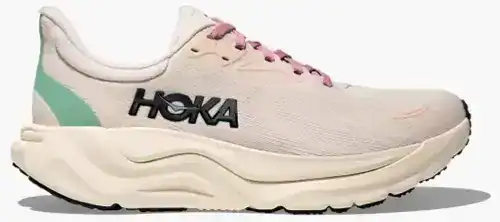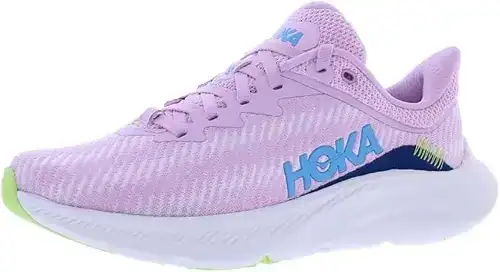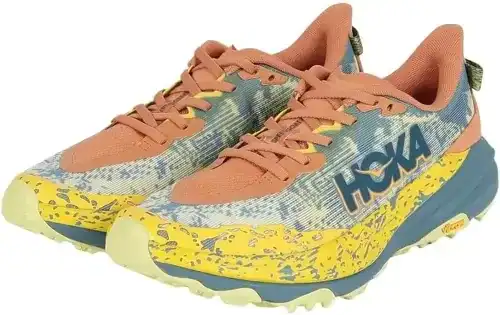Nurses spend long hours on their feet, often walking miles each shift. The right footwear can make a huge difference in comfort, posture, and long-term health. Hoka, known for its plush cushioning and foot-friendly designs, offers several models that meet the demands of healthcare workers. Whether you need a water-resistant shoe for spills, extra stability for flat feet, or a lightweight option for fast-paced environments, there’s a Hoka made for you. Below is a table of the best Hoka shoes for nurses in 2025, highlighting their top features and where to check the latest price.
Shoe Name | Best For | Features for Nurses | Price |
|---|---|---|---|
Maximum Cushioning | Supercritical EVA midsole, increased stack height, breathable recycled mesh upper, reflective details for night shifts | ||
Lightweight Comfort | Lightweight build, moderate cushioning, breathable upper | ||
Stability & Overpronation | J-Frame/H-Frame support structure, lighter sole, enhanced breathability | ||
Budget-Friendly Option | Balanced cushioning, streamlined for daily wear, good entry-level choice | ||
Versatility & Traction | Vibram Megagrip outsole, balanced midsole, great for nurses working in mixed or slippery indoor/outdoor conditions | ||
Post-Shift Recovery | Cushioned footbed, slip-on convenience, reduces foot fatigue after long shifts |
Reviews for best Hoka shoes for nurses
Hoka One One brand shoes are well known and much loved by nursing staff and medical workers thanks to their ample cushioning, traction and versatility. Here are our reviews.
Hoka Bondi 9
Best for: Maximum Cushioning

The Bondi 9 is Hoka’s most cushioned road shoe and a standout choice for nurses who spend all day on hard hospital floors. The 2025 update includes a supercritical EVA midsole that delivers softer impact and more energy return than earlier versions. A widened base and 2mm taller stack height improve stability and comfort, reducing joint strain.
The engineered mesh upper is breathable and made with 55% recycled materials, making it a more sustainable option. Reflective elements enhance safety for night-shift nurses walking to and from their vehicles. While still substantial underfoot, the Bondi 9 is lighter than its predecessor.
Some may find it bulky or stiff at first, but many wearers report a significant reduction in foot, knee, and hip fatigue after a few days of break-in. This shoe excels in any unit where comfort over long hours is a top priority.
Specs
- Weight: 10.5 oz (Men’s)
- Stack height: 43mm heel
- Drop: 4mm
Pros
- Ultra-plush cushioning
- Improved energy return
- Breathable, recycled upper
Cons
- Less responsive for fast-paced movement
- May feel bulky for some
Men’s version | Women’s version
Hoka Clifton 10
Best for: Lightweight Comfort

The Clifton 10 is the go-to option for nurses who prefer a lighter, more agile shoe without sacrificing cushioning. It’s built on Hoka’s early-stage Meta-Rocker for smooth transitions and features a breathable mesh upper to keep your feet cool during 12-hour shifts.
This model strikes an ideal balance between cushion and weight. It’s light enough to keep up with fast-paced work while still absorbing the pounding of long days on tile or concrete. The updated upper reduces hot spots and improves lockdown across the midfoot.
It’s not ideal for wet or oily surfaces, so if you work in a hospital kitchen or wet-floor environment, another option like the Bondi SR is better. But for dry floors and lots of movement, the Clifton 10 is hard to beat.
Specs
- Weight: 8.7 oz (Men’s)
- Stack height: ~29mm heel
- Drop: 5mm
Pros
- Lightweight and breathable
- Great cushioning-to-weight ratio
- Smooth ride for fast walkers
Cons
- Less slip protection
- May lack support for flat feet
Men’s version | Women’s version
Hoka Arahi 8
Best for: Stability & Overpronation

The Arahi 8 is ideal for nurses who need more structured support without the stiffness typically found in stability shoes. The latest model features Hoka’s refined J-Frame technology, now adapted with an H-frame design that provides a smoother, more secure ride—particularly helpful for overpronators or those with flat feet.
Despite being a stability shoe, the Arahi 8 maintains a surprisingly lightweight profile. Its breathable engineered mesh upper offers comfort during hot shifts and keeps your feet cool under pressure. A slightly firmer midsole gives it more responsiveness than the Clifton or Bondi, while still reducing fatigue over long hours.
The Arahi 8 may not be as cushioned as the Bondi 9, but its enhanced support and better midfoot containment make it a top pick for those with collapsing arches or gait issues.
Specs
- Weight: ~9.3 oz (Men’s)
- Drop: 5mm
- J-Frame/H-Frame support
Pros
- Excellent stability for overpronators
- Lightweight for a stability shoe
- Breathable mesh upper
Cons
- Less cushioned than Bondi or Clifton
- Firmer ride may not suit all preferences
Men’s version | Women’s version
Hoka Solimar
Best for: Budget-Friendly Option

The Hoka Solimar offers great value for nurses who want Hoka’s comfort and support at a more affordable price. While not as cushioned as the Bondi line, the Solimar provides a balanced ride with moderate cushioning and a versatile, sleek design.
It’s especially appealing for nurses who want a lower-profile shoe that transitions well from work to everyday wear. The EVA midsole offers a comfortable underfoot feel, and the minimal upper construction keeps the shoe lightweight and breathable.
The Solimar lacks some of the advanced features of higher-end Hokas (like the Bondi’s plush sole or the Arahi’s support frame), but for lighter-duty shifts or backup use, it delivers excellent value and comfort.
Specs
- Weight: ~8.0 oz (Men’s)
- Drop: 6mm
- Streamlined upper design
Pros
- Affordable price point
- Lightweight and versatile
- Great for casual or less intense shifts
Cons
- Less cushioning and support
- Not suited for high-demand environments
Men’s version | Women’s version
Hoka Speedgoat 6
Best for: Versatility & Traction

Originally designed as a trail running shoe, the Speedgoat 6 is perfect for nurses who work in environments with varied terrain—such as large hospital campuses, long corridors, or areas that involve indoor/outdoor transitions.
The standout feature is the Vibram Megagrip outsole, which delivers unmatched traction even on slick or wet surfaces. This makes it ideal for healthcare professionals working in facilities with inconsistent floor conditions.
Despite its rugged sole, the Speedgoat 6 is surprisingly light and well-cushioned. The midsole has been tuned for better responsiveness, and the upper has been refined to reduce weight while increasing durability.
If you want a shoe that combines all-day comfort with serious grip, the Speedgoat 6 is a great pick—especially for travel nurses or those who spend time in multiple work environments.
Specs
- Weight: ~10.0 oz (Men’s)
- Drop: 4mm
- Vibram Megagrip outsole
Pros
- Outstanding traction
- Durable and cushioned
- Works well for indoor/outdoor transitions
Cons
- Overbuilt for standard clinical settings
- May feel too firm for some users
Men’s version | Women’s version
Hoka Ora Recovery Slide 3
Best for: Post-Shift Recovery

The Hoka Ora Recovery Slide 3 is designed to give your feet a break after long hours on the job. While not built for hospital floor duty, it’s an essential recovery tool for nurses who need quick relief at home or during shift breaks.
This slide features a dual-layer construction with a soft top layer for immediate step-in comfort and a firmer base layer for support. Its oversized midsole and early-stage Meta-Rocker mimic the feel of Hoka’s running shoes, offering a smooth and cushioned experience for tired feet.
Ventilation channels in the footbed help reduce sweat and heat, while the slip-on style makes it easy to transition out of work shoes and into comfort. It’s a popular pick for anyone dealing with foot fatigue, plantar fasciitis, or just looking to pamper their feet after demanding shifts.
While it doesn’t offer the stability or grip needed for clinical work, it’s a near-perfect recovery option for downtime.
Specs
- Weight: ~6.5 oz
- Drop: 6mm
- Dual-layer EVA construction
Pros
- Immediate comfort after shifts
- Lightweight and easy to wear
- Meta-Rocker smooths out gait
Cons
- Not work-appropriate
- Open-toe design limits seasonal use
Men’s version | Women’s version
Hoka Buyer’s Guide for Nurses and Medical Professionals
For nurses and healthcare workers, the right pair of shoes can make the difference between an exhausting shift and one where your focus stays on your patients—not your feet. Long hours on hard hospital floors put constant pressure on your joints, arches, and heels. That’s why many nurses are turning to Hoka shoes, known for their thick cushioning, rocker soles, and ergonomic support.
Whether you’re working 12-hour shifts, covering long hallways, or standing for extended periods, Hokas can offer a blend of comfort and structure that helps prevent injury and reduce fatigue.
What to Look for in a Hoka Shoe for Nursing
When buying Hokas for medical work, consider the physical demands of your specific environment. Nurses often average 10,000 to 15,000 steps a day, typically on tile or linoleum floors with very little give. If you’re walking, turning, standing still at a patient’s bedside, or working on your feet without breaks, your shoes need to do a lot of heavy lifting.
Hokas are designed to provide:
- Cushioning that absorbs shock and reduces heel and joint pain
- Stability features that help correct alignment and reduce fatigue
- Breathable materials to manage heat and moisture buildup
- Lightweight construction that won’t weigh you down during long shifts
- Non-slip soles (though always check if they’re certified for your facility)
Unlike many sneakers that flatten after a few hours of standing, Hoka’s midsoles—made from compression-molded or supercritical EVA foam—maintain their structure throughout a full shift.
Best Hoka Models for Nurses in 2025
As of 2025, the most recommended Hoka models for nurses include the Arahi 8, Bondi 9, and Clifton 10. Each one suits different foot types and comfort needs.
The Arahi 8 is ideal if you need light stability. It uses Hoka’s J-Frame™ technology, which subtly supports overpronation without feeling stiff or corrective. This is a good match if you’ve experienced mild knee pain, arch fatigue, or shin splints during long shifts.
If maximum cushioning is your priority, the newly released Bondi 9 offers Hoka’s most plush ride yet. It now features a supercritical EVA foam midsole that’s lighter and more responsive than the Bondi 8. The updated knit upper also delivers better breathability and comfort during extended wear, especially if your feet tend to swell or feel hot by the end of your shift.
The Clifton 10 is a top choice for nurses who want a lightweight, neutral-cushion shoe. It’s especially helpful if you don’t need stability features but still want protection from tile flooring and joint pressure. It’s lighter than the Bondi and more flexible, which some healthcare workers prefer for faster-paced environments.
Fit, Width, and Practical Features
Most Hoka models are available in standard and wide widths, which is important if you have a naturally wider foot, wear compression socks, or experience swelling throughout the day. The wide toe box in all three recommended models also makes them a good option if you have bunions, neuromas, or need extra space to prevent rubbing and hotspots.
For hospital use, color choice may also be important. While Hoka offers bold designs, many models come in white, black, or grey options that comply with uniform policies. Mesh uppers can be treated with waterproofing sprays or paired with shoe covers to maintain hygiene standards.
It’s also worth rotating between two pairs of Hokas if you’re working several shifts per week. This allows the midsole to decompress between wears, prolonging the lifespan of the cushioning.